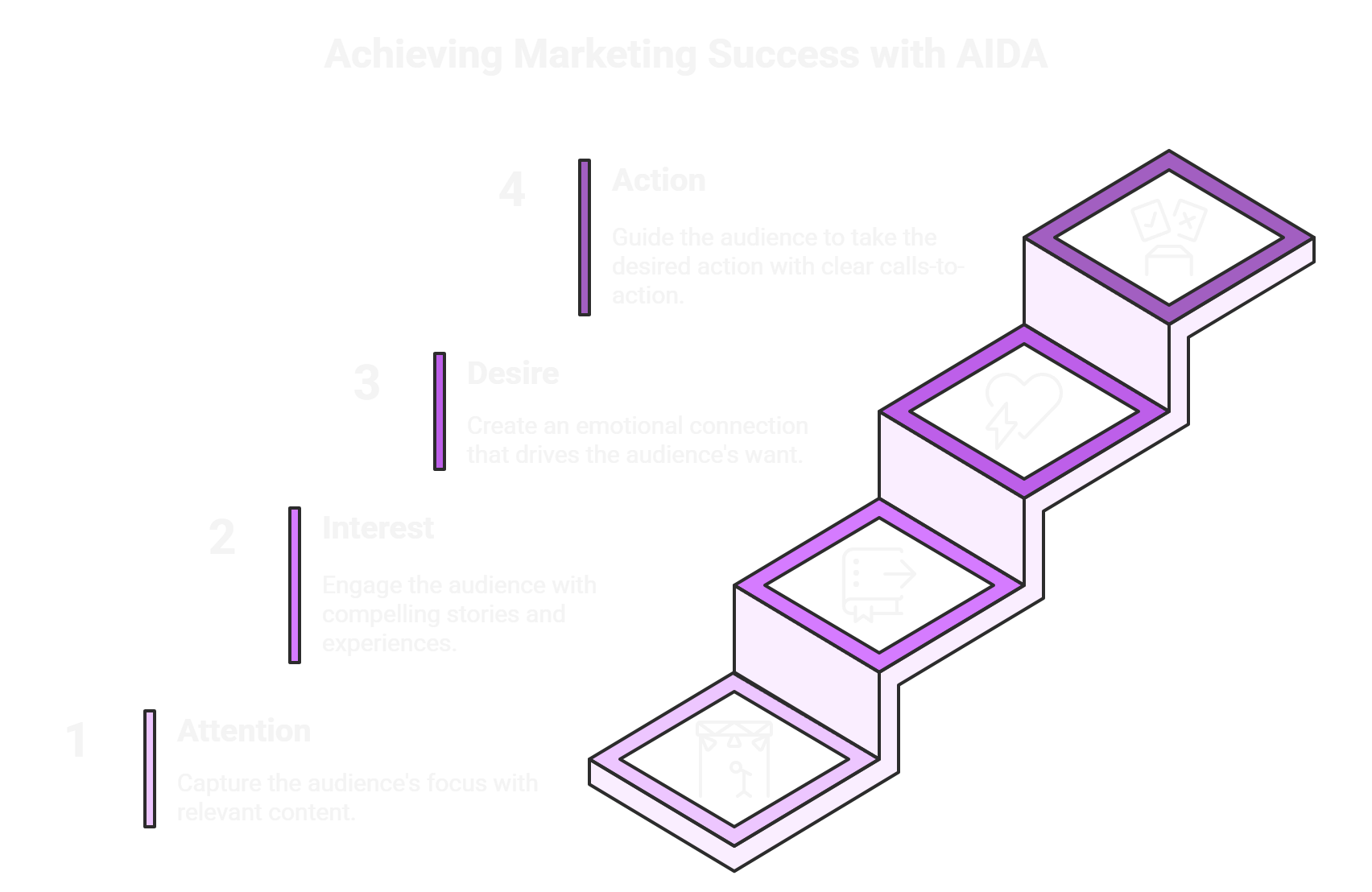The AIDA Model: Turning Strangers Into Buyers

Picture this: You're scrolling through your feed at 2 AM (don't judge, we've all been there), and suddenly you stop. Dead in your tracks. Something caught your eye, pulled you in, made you want it, and before you know it, you're typing in your credit card details for a product you didn't even know existed five minutes ago. Congratulations - you just experienced the AIDA model in action and probably didn't even realize it.
Here's a mind-bending stat that'll make your inner marketer dance: brands that master the AIDA framework see conversion rates up to 300% higher than those who wing it with random, hope-and-pray tactics. Yet somehow, in our AI-powered, TikTok-obsessed, algorithm-driven world, most marketers are still throwing spaghetti at the wall and wondering why their campaigns aren't sticking.
Let me be brutally honest: if you're not using the AIDA model in your digital marketing strategies, you're essentially showing up to a knife fight with a spoon. And not even a sharp spoon.
What Is AIDA in Marketing? The Framework That Refuses to Die
The AIDA marketing model isn't some shiny new marketing trend that'll be obsolete by next Tuesday. This battle-tested framework has converted strangers into customers since 1898, yes, you read that right. While other marketing models have come and gone faster than a viral dance trend, the AIDA model, explained in its simplest form, continues to dominate because it taps into something fundamental: human psychology.
The AIDA framework breaks down the customer journey mapping process into four distinct stages:
- A - Attention (Stop the scroll)
- I - Interest (Keep them hooked)
- D - Desire (Make them want it badly)
- A - Action (Get them actually to do something)
Think of it as the buyer psychology in marketing equivalent of a perfectly choreographed dance. Each of the step flows seamlessly into the next, creating a marketing funnel stage experience that feels natural rather than pushy. It's not about manipulating people - it's about understanding how human brains work when making purchasing decisions.
The AIDA Model Explained: Your Step-by-Step Conversion Playbook
Stage 1: Attention - The Art of Pattern Interruption
We live in an increasingly hyperconnected world wherein the average citizen views more than 5,000 adverts daily: getting attention is not only difficult, it is an Olympic event. Most marketers flunk at the attention step of the AIDA sales funnel because they find it tricky to be everything and something to every person.
This will hit in 2025:
Emotional advertising stimulation produces real pattern interruptions. Consider the Netflix ad campaign entitled Stranger Things that made the world turn upside down or the balls to hell video by Dollar Shave Club that made people want to watch ads about razors. These are not mistakes; they are deliberate attention-getters who value the pains of their audience and communicate with them.
The solution to conquering this step? Get out of trying to be clever and work towards being relevant. Your viewers or readers are not interested in your award-winning creative unless it helps them solve a particular problem, need, or desire you have created.
Step 2: Interest - The Engagement Sweet Spot
As soon as you manage to disrupt their scrolling trend, you will have an average of 3.7 seconds to demonstrate that you are worth their attention. No diligence is required there. That is where the AIDA model of digital marketing comes in a big way since it compels you to go beyond the catchy headline and brings home the value.
Interest does not focus on shoving features and benefits down people's throats; it is telling stories that evoke emotions. Look at Airbnb's campaign with its slogan of Belong Anywhere. They were not selling a place to sleep but the experience of belonging to this place, which was all about truly living a travel experience and being human. That is the workings of content strategy frameworks.
The contemporary sales funnel has heeded the fact that the current consumers are fixated on research. They will Google you, read reviews, stalk you on social media, and be likely to consult their friends before making any meaningful buying decision. What you want to do now in the interest phase is to make that research process as interesting as possible.

Stage 3: Psychology of Want - Desire
This is where psychology is delicious. Desire is not rational. It is emotional. It is between I must have this and I need this. The most powerful examples of the AIDA model in this phase realize that no one buys a product; they buy a better version of themselves.
Think about the marketing genius of Apple. They are not in computer sales but in sales of creativity, innovation, and a sense of belonging to the bigger picture. Tesla does not sell cars but the future, the awareness of ecology, and prestige. The brands have perfected making their products seem to be identity statements but not purchases.
The secret weapon, in this case, is social proof. All desired amplifiers are user-generated content, testimonials, case studies, and reviews. But the thing is that in most cases, natural, raw social proof is more likely to convert than sheerly well-designed testimonials. Consumers prefer dirty, real-life stuff to polished marketing use.
Stage 4: Action - The Conversion Catalyst
The world's interests and desires are no good if you mess up during the action phase. Most marketers defeat this at the end of the race by complicating the process of taking up call-to-action tips and failing to provide a call-to-action tip altogether.
It is an interesting aspect of psychology that an individual cannot take any other step without clearance. You see, even when they are interested in purchasing something, they still require that little nudge, that unambiguous message on the next step. The marketing call-to-action advice you get should eliminate every source of friction, build a sense of urgency, and avoid sleaziness.
Consider one-click ordering at Amazon or the easy-to-use continue-watching option at Netflix. All this is not by chance but well-planned action machines that eliminate the distance between lust and satisfaction.
AIDA Model Examples That Work in 2025
How to Use AIDA in Email Marketing
Although email marketing may sound old, it has a $42 ROI for each dollar of cost. AIDA model makes ordinary blast email conversion machines:
- Attention: Subject lines that make it wonder or urgent.
- Interest: Lines that give value as soon as they open.
- Desire: The content that creates a picture of change.
- Action: Clear and single-objective CTAs that take away the fatigue of decision-making
An outstanding example? The daily newsletter of Morning Coffee. They channel attention via catchy subject lines, uphold interest using conversational style, generate desire using exclusive and privileged information, and action them using strategic sponsor positioning that seems natural to the story.

AIDA vs AIDAR: The Evolution Continues
The conventional AIDA model has been developed for AIDAR by smart marketers with the addition of a fifth step of Retention. Why? It is important to understand that it would cost 5-25 times more to get a new customer than to retain an old one. The AIDAR model incorporates the customer journey starting after the purchase and should be where the journey retention strategies involve onboarding sequences, loyalty, exclusive content, and community building.
Sephora and Starbucks brands have made Retention an art form, making people feel appreciated even after exchanging money the first time.
Marketing with AI Tools: Accelerating Your AIDA Implementation
Here is where the tone starts getting hot. Artificial intelligence will revolutionize marketing models in 2025, and AIDA will not be left behind. Artificial intelligence can streamline every step of your funnel like Don Draper would have cried.
Headline generators based on artificial intelligence can scale the creation of attention-catching material. Depending on a behavioural customer's behaviour, interest-related building material can be tailored using machine learning algorithms. Predictive analytics can determine desired triggers in discrete groups of audiences. Action mechanisms can be optimized in real-time using smart automation.
This is the plot twist: AI does not negate the necessity to grasp human psychology but will only increase it. It is the marketers who can blend the efficiency of AIs with human empathy that will win in 2025; the technology to scale empathy, not replace it.
The Sales Conversion Funnel Reality Check
Enough with the elephant in the room: the classical approach of AIDA presupposes a linear customer process, yet a customer buying process is not linear nowadays. The modern customer could learn about you on TikTok, research on Google, compare with other vendors in a discussion on Reddit, and eventually convert to a precisely implemented email in three weeks.
The more sophisticated kind of marketing funnel stage thinking comes in here. The AIDA tool is more advantageous when used flexibly across various points of contact instead of a hard formula of a single size. Every exchange must take the prospects through the AIDA continuum, no matter what point of your ecosystem they came in.
Content Strategy Frameworks: Making AIDA Actionable
What is beautiful about the AIDA model is that it is versatile. Whether designing blogs' content, creating social media campaigns, landing pages, or video-based content, the framework offers an effective pattern of conversion-oriented messaging.
In the case of a blog, your headline should be able to attract attention; the intro should be able to trigger interest; the body should be able to stir up a desire due to valuable information; and finally, a conclusion that leads to action through prescribing what the next step should be. In the case of social media, your picture draws attention, your caption generates interest, your story develops desire, and your CTA makes people act.
The trick is to remain consistent in all the points of contact but handle the message differently to those of the platforms they exist on and the audience using those.
The Customer Journey Mapping in the Future
The AIDA framework is still developing as we look into the future. New possibilities to apply AIDA principles emerge in optimizing voice search, adding augmented reality experiences and interactive content.
Our way of getting attention is transforming with smart speakers. AR filters are virtually transforming interest construction. Personalized suggestions are revolutionizing the desire to create. And the one-click buying is transforming our process of driving action.
The marketers that survive will be the ones who realize that the only thing that can alter is the channel but that the basic psychological human nature of the AIDA model will always remain the same.
Your AIDA Action Plan: From Theory to Results
So, here is an action plan on how to implement AIDA model:
- Perform an audit of existing marketing material using the AIDA model
- Find weaknesses in your conversion funnel
- Experiment with every stage of AIDA
- Measure and optimize using real data and not assumptions
- Scale different things that are working and kill what is not.

And remember, the AIDA model is not a magic bullet but is a consideration based on either strategy, creativity, or constant trying to optimize. However, when used correctly, random marketing can be turned into systematic conversion machines.
CONCLUSION: Why AIDA Still Rules
In a world where the latest marketing trends and growth hacking shortcuts are the buzzwords, the AIDA model reminds us that things are the way they are, not because they are new and exciting. It is the cumulative version of marketing compound interest, yawn, but it is an accumulation over time.
Brands which have perfected AIDA do not simply make customers but advocates. They do not only drive transactions but also create relationships. They are not conversion-oriented; they are long-term value-oriented.
This is why next time someone says that the traditional marketing frameworks are dead, you can always say to them that the death of AIDA has been very much over-reported. It is more alive than ever; it is only that it has gotten a lot more intelligent in its mode of operation in our digital-first world.
It is not a question of whether the AIDA model works anymore. And the question is, are you ready to give up on your desire for marketing miracles and begin to construct systematic conversion machines?
Your transformation to become strangers to customers begins with recognizing this simple truth: people do not buy products or services. They purchase improved versions of them. The AIDA model is merely the path map that takes them there.



